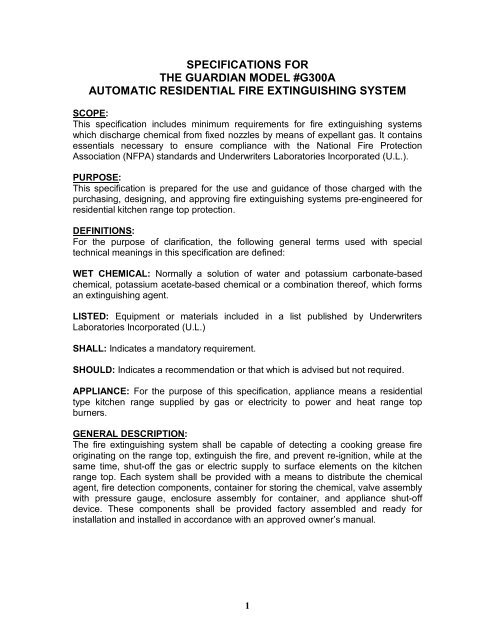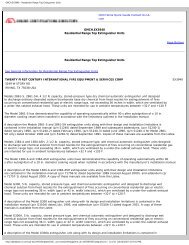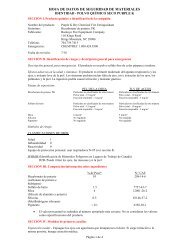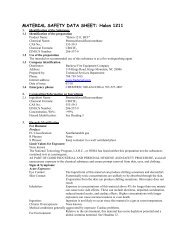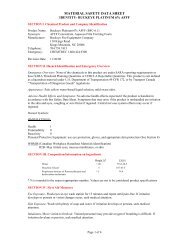specifications for the guardian model #g300a automatic - Fesco-Fire ...
specifications for the guardian model #g300a automatic - Fesco-Fire ...
specifications for the guardian model #g300a automatic - Fesco-Fire ...
Create successful ePaper yourself
Turn your PDF publications into a flip-book with our unique Google optimized e-Paper software.
SPECIFICATIONS FOR<br />
THE GUARDIAN MODEL #G300A<br />
AUTOMATIC RESIDENTIAL FIRE EXTINGUISHING SYSTEM<br />
SCOPE:<br />
This specification includes minimum requirements <strong>for</strong> fire extinguishing systems<br />
which discharge chemical from fixed nozzles by means of expellant gas. It contains<br />
essentials necessary to ensure compliance with <strong>the</strong> National <strong>Fire</strong> Protection<br />
Association (NFPA) standards and Underwriters Laboratories Incorporated (U.L.).<br />
PURPOSE:<br />
This specification is prepared <strong>for</strong> <strong>the</strong> use and guidance of those charged with <strong>the</strong><br />
purchasing, designing, and approving fire extinguishing systems preengineered <strong>for</strong><br />
residential kitchen range top protection.<br />
DEFINITIONS:<br />
For <strong>the</strong> purpose of clarification, <strong>the</strong> following general terms used with special<br />
technical meanings in this specification are defined:<br />
WET CHEMICAL: Normally a solution of water and potassium carbonatebased<br />
chemical, potassium acetatebased chemical or a combination <strong>the</strong>reof, which <strong>for</strong>ms<br />
an extinguishing agent.<br />
LISTED: Equipment or materials included in a list published by Underwriters<br />
Laboratories Incorporated (U.L.)<br />
SHALL: Indicates a mandatory requirement.<br />
SHOULD: Indicates a recommendation or that which is advised but not required.<br />
APPLIANCE: For <strong>the</strong> purpose of this specification, appliance means a residential<br />
type kitchen range supplied by gas or electricity to power and heat range top<br />
burners.<br />
GENERAL DESCRIPTION:<br />
The fire extinguishing system shall be capable of detecting a cooking grease fire<br />
originating on <strong>the</strong> range top, extinguish <strong>the</strong> fire, and prevent reignition, while at <strong>the</strong><br />
same time, shutoff <strong>the</strong> gas or electric supply to surface elements on <strong>the</strong> kitchen<br />
range top. Each system shall be provided with a means to distribute <strong>the</strong> chemical<br />
agent, fire detection components, container <strong>for</strong> storing <strong>the</strong> chemical, valve assembly<br />
with pressure gauge, enclosure assembly <strong>for</strong> container, and appliance shutoff<br />
device. These components shall be provided factory assembled and ready <strong>for</strong><br />
installation and installed in accordance with an approved owner’s manual.<br />
1
CERTIFICATION:<br />
The fire extinguishing systems shall have a current U.L. listing under <strong>the</strong> category<br />
“Residential Range Top <strong>Fire</strong> Protection” in <strong>the</strong> most recent <strong>Fire</strong> Protection<br />
Equipment Directory (FPED).<br />
CHEMICAL AGENT:<br />
WET CHEMICAL: Shall con<strong>for</strong>m to <strong>the</strong> requirements of National <strong>Fire</strong> Protection<br />
Association (NFPA) Standard No. 17A <strong>for</strong> Wet Chemical <strong>Fire</strong> Extinguishing Systems.<br />
SYSTEM COMPONENTS:<br />
SYSTEM ENCLOSURE: The system enclosure shall consist of <strong>the</strong> pressurized<br />
extinguisher cylinder with wet chemical fire suppressant, central processing unit<br />
control board with terminal block connections, electronic release valve, cylinder<br />
pressure gauge, enclosure base, and enclosure cover.<br />
Operation of <strong>the</strong> extinguisher unit is controlled by <strong>the</strong> supervised electronic control<br />
panel, which is battery powered. Detection is initiated through <strong>the</strong> heat sensors,<br />
activating <strong>the</strong> alarm and <strong>the</strong> extinguisher. The electric or gas shutdown devices can<br />
ei<strong>the</strong>r be sonically operated by <strong>the</strong> control panel, or hardwired to <strong>the</strong> central<br />
processing unit control board.<br />
CYLINDER AND VALVE ASSEMBLY: The extinguisher cylinder and valve<br />
assembly shall be provided fully charged with chemical and pressurized with dry<br />
nitrogen in accordance with listed requirements. A pressure gauge attached to <strong>the</strong><br />
valve assembly shall be positioned to allow visual inspection when installed within a<br />
kitchen cabinet. Maximum allowable height of container (including <strong>the</strong> enclosure<br />
assembly) shall not exceed 12 inches. The container and valve assembly shall be of<br />
<strong>the</strong> reserviceable type and provide maintenance requirements synonymous with<br />
that required <strong>for</strong> portable handheld fire extinguishers, according to National <strong>Fire</strong><br />
Protection Association (NFPA) Standard 10. The container and valve assembly shall<br />
be provided factory assembled to <strong>the</strong> enclosure. Assembly shall include a pre<br />
mounted CPU control board <strong>for</strong> <strong>the</strong> appliance shutoff device and necessary<br />
attachment <strong>for</strong> <strong>the</strong> <strong>Fire</strong> Detection Unit.<br />
The complete extinguisher cylinder and valve assembly shall be installed in a<br />
protected area above <strong>the</strong> range hood (normally, kitchen cabinets). Installations<br />
which expose extinguisher cylinder and valve assembly to direct cooking heat and<br />
grease will not be accepted.<br />
CENTRAL PROCESSING UNIT CONTROL BOARD:<br />
The CPU control board is housed / attached inside <strong>the</strong> system enclosure. The<br />
control board’s circuitry is powered by a 9V DC battery and has <strong>the</strong> following<br />
features:<br />
SUPERVISED CIRCUITRY: The audible 106DB alarm on <strong>the</strong> CPU control board will<br />
“alarm” to warn of possible trouble in <strong>the</strong> electronic circuitry including <strong>the</strong> heat<br />
sensors, if <strong>the</strong>re is an open circuit.<br />
SYSTEM OPERATION LIGHT: The red “power” light will blink approximately every<br />
45 seconds to confirm <strong>the</strong> system is operating.<br />
2
AUDIBLE ALARM: The system 106DB alarm is designed to continuously sound<br />
once <strong>the</strong> system has been activated by a stove top fire.<br />
LOW BATTERY WARNING: The audible alarm on <strong>the</strong> CPU control bard will “chirp”<br />
approximately every 45 seconds when a low battery condition exits. If this condition<br />
exists, 9V DC battery must be replaced immediately to insure proper system<br />
operation.<br />
AUXILIARY OUTPUTS: Can be connected to <strong>automatic</strong> telephone dialers,<br />
monitored security alarm systems or o<strong>the</strong>r warning/protective equipment. Auxiliary<br />
outputs provide one (1) second impulses to activate above items. These connections<br />
are rated at 5 AMP at 250V AC.<br />
TEMPERATURE ACTIVATED SENSOR ASSEMBLY:<br />
The sensor assembly shall consist of two (2) metal housed detector assemblies<br />
containing diodetype heat sensors, affixed to <strong>the</strong> side of <strong>the</strong> magnetic nozzle bases,<br />
and connected to <strong>the</strong> CPU control board with two (2) different wire lengths.<br />
DISTRIBUTION ASSEMBLY:<br />
The distribution assembly shall consist of two (2) Teflonlined stainless steel braided<br />
hoses and two (2) magnetic based adjustable nozzle assemblies. The use of copper<br />
tubing shall not be accepted. Hose and nozzles shall comply with NFPA Standard<br />
No. 17A <strong>for</strong> Wet Chemical Extinguishing Systems and shall have been investigated<br />
by Underwriters Laboratories, Inc. (U.L.) and listed <strong>for</strong> this service.<br />
APPLIANCE NOZZLES:<br />
Wet System: Appliance nozzles shall be constructed of brass. Appliance nozzles<br />
with painted surfaces shall not be accepted. Appliance nozzles shall not extend<br />
below <strong>the</strong> lowest component of <strong>the</strong> range hood. Design shall provide equal<br />
distribution of chemical agent and allow chemical to flow effectively with low velocity<br />
to avoid splattering of burning grease.<br />
APPLIANCE SHUTDOWN DEVICE:<br />
Each system shall be provided with a listed device to <strong>automatic</strong>ally shutoff <strong>the</strong> gas<br />
or electric supply to surface burners on <strong>the</strong> kitchen range top upon activation of <strong>the</strong><br />
alarm from <strong>the</strong> fire detection unit via an interconnection cable. The gas or electric<br />
supply shall remain “off” until manually reset. Electrical power cutoff to kitchen<br />
range hood exhaust fan shall not be required <strong>for</strong> Underwriters Laboratories<br />
Incorporated (U.L.) listed extinguishing systems.<br />
GAS SHUTOFF: Once activated via a low voltage interconnection cable, <strong>the</strong> gas<br />
valve will remain in <strong>the</strong> closed position and will require manual reset by<br />
depressing <strong>the</strong> reset button located on <strong>the</strong> top of <strong>the</strong> gas control box. The gas<br />
control box is powered by <strong>the</strong> 110v outlet behind <strong>the</strong> range.<br />
3
ELECTRIC SHUTOFF: Once activated via a low voltage interconnection cable it<br />
will close <strong>the</strong> electrical current to <strong>the</strong> range and must be manually reset. You can<br />
reset <strong>the</strong> shutoff by ei<strong>the</strong>r unplugging it from <strong>the</strong> wall & plugging it back in, or by<br />
resetting <strong>the</strong> breaker <strong>for</strong> <strong>the</strong> range.<br />
OWNER’S MANUAL:<br />
Each system shall be provided with a comprehensive owner’s manual that shall<br />
contain procedures <strong>for</strong> post cleanup, parts identification, a complete wiring diagram,<br />
system installation with pictorials <strong>for</strong> stepbystep procedures, system limitation, and<br />
inspection & maintenance requirements. Reservicing/recharging procedures can<br />
also be contained in <strong>the</strong> owner’s manual.<br />
OPTIONAL EQUIPMENT:<br />
MANUAL REMOTE PULL STATION: Device shall be U.L. Listed or Recognized<br />
Component supplied complete with wire leads and listed with <strong>the</strong> residential system.<br />
REMOTE AUDIBLE ALARM: Where a cabinet design or material thickness prohibits<br />
<strong>the</strong> DB (loudness) level from activating <strong>the</strong> shutoff a remote 106 DB alarm shall be<br />
installed under <strong>the</strong> range hood. Only a remote alarm listed and compatible with <strong>the</strong><br />
central processing unit control board shall be used.<br />
REMOTE ALARM & STROBE LIGHT COMBINATION: An 110v alarm and<br />
strobe light combination is also available to aid in in<strong>for</strong>ming o<strong>the</strong>r persons, as<br />
well as <strong>the</strong> hearing impaired, that <strong>the</strong>re is a cooking fire.<br />
ALARM INTERFACE ENCLOSURE: When <strong>the</strong> system needs to be monitored<br />
by a building alarm, an alarm interface enclosure may be required <strong>for</strong> monitoring<br />
purposes.<br />
WIRELESS RECEIVER: An optional wireless activated receiver may be installed<br />
to make ei<strong>the</strong>r <strong>the</strong> gas or electric shutoff wirelessly operated by taking <strong>the</strong> place<br />
of <strong>the</strong> interconnect cable. All wiring, fittings, and connections shall comply with<br />
NFPA Standard 70 and local codes & ordinances. Each electrically or gas supplied<br />
kitchen range appliance can be provided with a U.L. Listed wireless receiver. The<br />
wireless receiver unit continuously monitors <strong>for</strong> an alarm from <strong>the</strong> central processing<br />
unit control board. The alarm sounds to activate <strong>the</strong> sonic shutoff unit. Once<br />
activated, all electrical power and gas (when applicable) to <strong>the</strong> range is shut off, and<br />
must be manually reset.<br />
AC/DC WALL PLUG IN POWER SUPPLY: Where a constant 9 volt power source is<br />
required an AC/DC wall plug in trans<strong>for</strong>mer can be supplied. Only a U.L. Listed<br />
AC/DC wall plug in power supply that has been tested and listed with <strong>the</strong> central<br />
processing control board shall be used.<br />
4


